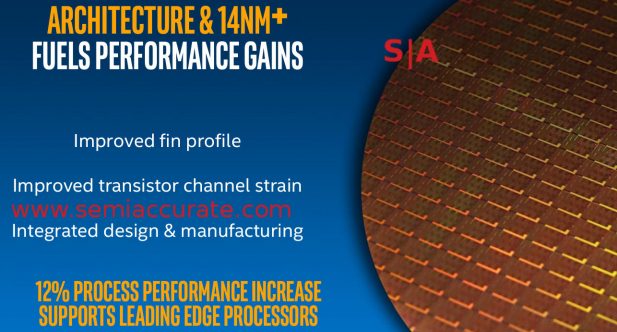
Posted on 09/02/2016 12:44:02 PM PDT by Ernest_at_the_Beach
With the innovation in Intel’s Kaby Lake 7th Generation Core CPU line, the process improvements Intel brought to bear have been lost in the buzz. This is unfair because according to the presentations provided by Intel, they have finally narrowed the timing gap to industry leader Samsung on process technology. Timing isn’t the only important part of a process though, the technology matters too and Intel has a lot more work to do there if they want to catch Samsung.

Slideware can hide performance gaps
Intel provided the data in their Kaby Lake briefing to show how much they narrowed the timing gap to Samsung. Intel released their second generation 14nm FinFET process called 14nm+ this week, Samsung released theirs on January 14, 2016. While SemiAccurate may be exaggerating a bit by calling this gap 3Q, 8.5 months is still less than a year. As long as Intel’s release is to be taken at face value like they want it to be, the progress they made is still remarkable.
(Excerpt) Read more at semiaccurate.com ...
fyi
With or to? Or is there no difference?
What is Samsung’s Technology used in?
Smartphones? Tablets?
I thought AMD and Intel were the only manufacturer of processors.
And Apple...They do their own design,..
There is also a July 2015 aericle from EE imes about IBM and a SUNY Team doing a working chip at 7 nm with new Materials ....will be searching for that,...amazing stufff going on!
Remember 20-odd years ago feature sizes under 1000nm were considered impressive?
Yup.
I'm a retired chip-maker, 1994.
We were running 1.5 microns (1500nm) in production and beginning to run 1.0 micron feature sizes in production. And, experimenting with 0.5 micron sizes.
I figured you’d know.
AMD Has Plans To Create The ‘Starship’ Processor With 48 Cores / 96 Threads On The 7nm Node
Also has an imbedded link to the EE Times article regarding the 7 nm chip by IBM and SUNY Research Lab.
High-speed GaAs/AlGaAs optoelectronic devices for computer applications
Intel Abandoning Silicon With 7nm and Beyond – Silicon Alternatives Coming By 2020
2 years ago by Khalid Moammer
********************************************EXCERPT************************************************
Intel revealed that the end of the road for Silicon is nearing as alternative materials will be required for the 7nm node and beyond. This is perhaps one of the more interesting stories that came out of this year’s international solid state conference.
 It has been well known that Silicon is running out of steam but it was previously believed that Silicon would make it at least to 7nm. Intel however believes that Silicon alternatives will be required for the 7nm process and beyond.
It has been well known that Silicon is running out of steam but it was previously believed that Silicon would make it at least to 7nm. Intel however believes that Silicon alternatives will be required for the 7nm process and beyond.
Moore’s law which is the observation that transistor density doubles every year, later amended to every couple of years, has slowed down dramatically in the past few years. Scaling Silicon transistors down has become increasingly difficult and expensive and at around 7nm it will prove to be downright impossible.
Digital computing which is what the entire world has relied on for the past several decades is based on one basic concept, on or off. The zeroes and ones in binary simply indicate if a signal is present or not. The fundamental flaw with Silicon transistors is that at the 7nm point the transistors sit so close to each other that an effect called quantum tunneling occurs. This effect unfortunately means that the transistor cannot reliably be turned off and for the most part will stay on.
Disclaimer: Opinions posted on Free Republic are those of the individual posters and do not necessarily represent the opinion of Free Republic or its management. All materials posted herein are protected by copyright law and the exemption for fair use of copyrighted works.